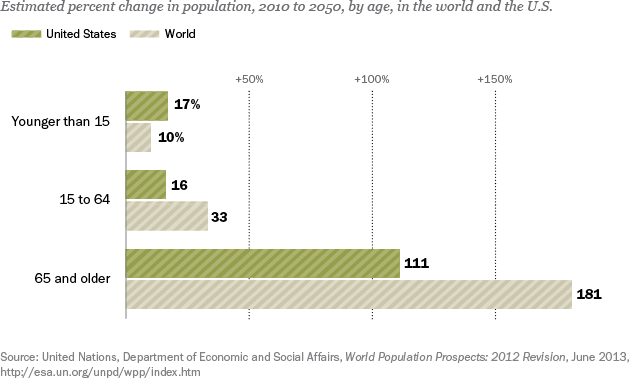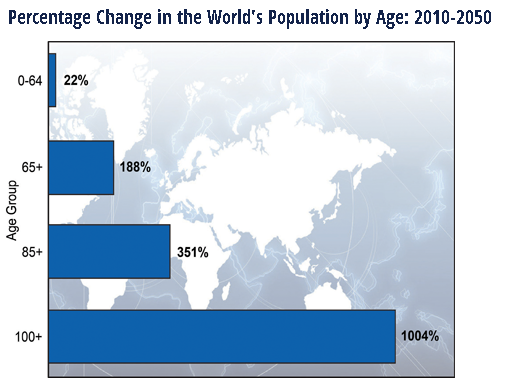Policymakers around the world are facing a problem of potentially critical proportions: a substantial increase in older people (65 years of age and beyond) and shrinking number of children (15 years old and younger). Not only is this trend impacting established countries such as Japan, Germany, Italy, and Canada, but also emerging economies such as China and India. From an economic perspective, a growing senior population will mean reallocating economic and other resources from research and development, improving educational systems, and technological advancements to caring for the elderly, more funds to pay for senior healthcare, and maintaining pension fund payouts.
With fewer younger people, there will be less number of workers who will make products and provide services for the rest of the global population. This will ultimately mean slower economic growth on a global scale, lower long-term productivity, and higher taxes for the remaining workforce. Projections have been made that the population of individuals over 60 years old will reach 1 billion by the year 2020 and nearly 2 billion by 2050 which will represent 22 percent of the global population. Other age groups are also projected to increase: individuals 80 or older will rise from 1 percent to 4 percent of the world’s population between the years 2010 and 2050. Overall, there will be economic implications in this shift in size of age groups that will involve making decisions by policymakers in the allocation of economic and financial resources affecting everyone.
Phenomenon of an aging population
There are many reasons that can explain the phenomenon of an increasingly aging global population.
Increases in life expectancy
Globally, people are living much longer than previously in recorded human history. The United Nations has projected that global life expectancy has gone up from 47 years in 1950 to beyond 65 years of age in 2010 and projects that it will reach 75 years by 2050. The increase in life expectancy can be rooted in declining infant mortality rates as well as the decreasing number of children deaths from childhood diseases. This has allowed more children to advance into adulthood and eventually old age. For example, 50 percent of the population of mid-19th century England were dead prior to reaching their mid-40s. Presently, 50 percent of England’s population have a good chance of survival until well into their mid-80s.
While this means that more people will be able to enjoy what life has to offer, it also means that the number of elderly will see a substantial increase. It is projected that globally the number of elderly will rise from 6.9 percent of the world’s population in the year 2000 to a projected 19.3 percent in 2050. For the developed regions, individuals 60 and over will make up one-third of their population while for developing nations it will only consist of one-fifth. In terms of sheer numbers, according to the Pew Research Center, individuals 65 and older will be expected to triple from 531 million in 2010 to 1.5 billion in 2050.

Medical advances and better health care
Due to the development of vaccines, antibiotics, and advances in medicine, people now have a better chance of surviving childhood and reaching old age. Advances in public health and medical research have allowed the development of vaccines against polio, smallpox, and measles. If a child develops pneumonia, it is no longer regarded as a possibility of a death sentence. Due to a better understanding of the need for a nutritious and healthy diet, better sewage treatment, and clean water standards, the chances of a child contracting a serious infection has decreased dramatically in the past 100 years. This has allowed children to build up immunities, survive potentially life-shortening diseases, become thriving adults, and actually see a 24-year increase in global life expectancy.
Rising number of oldest of the old
It is not just the increasing number of people living past the age of 65 years or even 75 years old, but that people are actually living much, much longer than anticipated. Officially, these individuals are regarded as the oldest of the old since they are living past the age of 85 years. The oldest of the old make up approximately 7 percent of the global elderly population in which they constitute 10 percent in developed nations and 5 percent in underdeveloped countries. The nations of China, India, Japan, the United States, Germany, and Russia have more than 50 percent of the world’s oldest old. Globally, the oldest old population is expected to rise by 151 percent between the years 2005 and 2030 while the number of elderly 65 and over will increase 104 percent and there will only be a 21 percent increase for individuals under the age of 65. This could possibly mean that more people will have a better chance of living past the age of 85 and even reach age 100 than previously in human history.

Source: United Nations, World Population Prospects: The 2010 Revision.
Lower fertility rates
While the world’s elderly population is increasing, there are fewer young people and children to replace them. The number of children being born per woman has decreased from 5.0 in 1955 to 2.7 in 2005. In developed nations, the decrease has gone from 2.8 children born per woman in 1955 to 1.6 in 2005, which is substantially below the replacement rate of 2.1 births for every woman. For developing nations, the situation is not any better: in 1950 6.2 children were born for every woman but in 2005 it went down to 2.9. This decline of children being born will impact the world’s pace of its population growth as well as its aging population. With an increase in the elderly population and a decrease in children being born, there will ultimately be a shrinking global population as well as less workers and consumers. This will impact the products and services companies can offer. This will also affect the “old-age dependency ratio” which is the number of working individuals to people age 65 or older. The United States Census Bureau data has shown that for every 100 working-age Americans there are currently 21 at the age of 65 or older. However, this ratio will increase to 35 by the year 2030. The decline in fertility rates will also mean changes in traditional family relations and structure, and problems with caregiving.
Click on image to view larger version
Economic implications of an aging population
An aging global population will have a serious impact on the world’s economies to the point of hampering growth and changing public policy. Among the economic factors that will be affected are:
Shrinking populations
Due to an increasing aging population, nations will see that these elderly individuals will soon die off. Combined with lower fertility rates and reduced replacement of people, nations have started to experience shrinking populations. For example, nations such as Japan and Italy are starting to see their populations age considerably. Japan has the oldest population in the world in which 26.3 percent of its people are over age 65 while in 2014 the rate was 25.8 percent. It is predicted that Japan will have 32.2 percent of its people as senior citizens by the year 2030. Japan is also experiencing a dwindling population in which people between ages 15 and 64 decreased by 4 percent between 2000 and 2010. Italy has 22.4 percent of its population at 65 years or older. At the same time, its young population has not increased since 1999 and is only 14 percent of the country’s population.
Other nations are experiencing similar problems. In an unprecedented situation, the United States is seeing its population beginning to age. For example, in 1980, there existed 19 American adults over age 65 for every 100 Americans living between the ages of 18 and 64. However, by 2017 there are 25 Americans over 65 for every 100 individuals who are of working age. The United States has long been regarded as a country generally immune from the global aging phenomenon. But now it is starting to occur in a gradual way.
It is expected that by 2020, countries such as China (32 million), Russia (1.8 million), Iran (1.7 million), and as well as the United States (1.4 million) will see shrinkage of people between the ages of 15 and 24. Presently, forty nations have shrinking working-age populace which has increased from nine in the late 1980’s. Countries such as Lithuania has seen its number of young people between the ages of 15 and 64 shrink from 2.5 million in 1990 to 2 million in 2015. Combined with a severe drop in its birth rate, Lithuania has seen fewer adults coming into the workforce. The United Nations has projected that by 2030, Lithuania will have only 1.6 million adults of working age which will revert it to the same level as in 1950.
Reduced economic growth
Nations experiencing a shrinking population will see a reduction in financial capital that could be used for long-term investment and enhancing economic growth. Due to a shrinking population and more elderly people there will be a reduction in public savings since governments will use those funds in taking care of the elderly. Nations will actually start seeing their economies shrink and economic growth rates decrease. For example, the Federal Reserve Bank of the United States is projecting that America’s potential growth rate has seen a drop from 3 percent to 2 percent due to an aging population. In other nations, the situation is expected to be dire. With China’s working age population expected to decline from 67 percent to 57 percent over the next 25 years, its per capita Gross Domestic Product (GDP) will decrease by 15 percent by 2040. A recent study by the RAND Corporation looked at different groups of nations by older and younger populations. RAND found that annual GDP growth is expected to decrease by 1.2 percent because of an aging population. It was not only due to older people less likely to be participants in the working population but because they were less productive on a per-worker basis. The bottom line is that an increasing aging population will have an impact on the rate of economic growth and therefore affect every member of society.
Effect on Pensions
With an increasing aging population, many nations will see that their pension systems will be hurt financially. A recent case is Russia in which Vladimir Putin announced that the nation’s retirement age would now be 65 for men and 63 for women. This is necessary in order to provide retirement benefits for Russians since the country’s pension fund uses subsidies worth approximately 2.5 percent of GDP. The raising of the nation’s retirement age is necessary since the number of Russia’s pensioners is growing at faster pace than the number of workers paying into the system. But Russia is not the only county with such problems. In Germany, pension payments along with medical care and other ancillary items for eligible elderly individuals comes to 26 percent of the country’s GDP in 2014, or approximately 60 percent of government expenditures. Studies have shown that if present trends continue in Germany, the amount will increase to 29 percent of GDP by the year 2060. With an increasing aging population on a global basis, nations such as Russia, Germany, and even the United States will have to come up with more money to pay for government-sponsored pensions. Other nations such as Italy, find themselves in a similar dilemma. In 2015, Italy’s total pension spending was at 16.5 percent of its GDP which was the second-highest in the European Union after Greece. The United States is facing the problem that private pension funds will be stretched in the future as its elderly population increases and that private pension assets will have to increase beyond its present rate of 12 percent of household financial assets. Pensions, both private and public, will need to get a higher return on their investments in the long-term in order to provide a sustainable payout to pensioners. If not, then those paying into the fund will need to increase their contributions.
Effect on health care systems
As individuals age, their health generally declines. This means an increase in frailties, disabilities, and chronic diseases such as cancer, Alzheimer’s, respiratory and heart problems. This will involve more and expensive health treatments in order to properly care for elderly patients or to make their conditions comfortable. But such care, depending on the nation’s health program, will be expensive and will have to be paid for somehow. For example, in Europe government spending for health care takes up a great deal of governmental budgets. The OECD has reported that Europe’s population over age 65 takes up 40 to 50 percent of healthcare spending while per capita health costs come to three to five times greater than for those under 65. Countries such as France, Germany, and the Netherlands have the highest healthcare expenditures in Europe. As Europe’s elderly population continues to increase and get older, healthcare costs are expected to rise even further. Nations will be forced to improve their healthcare systems so they are more effective and efficient in order to provide better treatment for the elderly at a lower cost. But this will mean that governments must either completely revamp how healthcare is provided to both the elderly and younger people or make it more competitive in order to be efficient and at a lower cost.
A Growing Problem
For humanitarian purposes, providing for the elderly is an important consideration for any government. But the problem is how to deal with the economic and financial implications of a growing aging population. Resources will either be reallocated from young to old people or countries must change their policies. Policy changes include allowing more immigrants into their borders in order to take care of the growing number of elderly or enter the workforce in order to pay taxes to fund pensions and national healthcare plans. Some nations have gone so far as to pay women to have more babies so as to reverse their shrinking populations. The problem is huge and the solutions are difficult, but something must be done or else the situation will only get worse.
 Arthur Guarino is an assistant professor in the Finance and Economics Department at Rutgers University Business School teaching courses in financial institutions and markets, corporate finance, investments, and financial statement analysis. The first half of his career was spent in the financial services industry working for corporations such as TIAA-CREF, Met Life, and The Bank of New York. He writes articles dealing with finance, economics, and public policy.
Arthur Guarino is an assistant professor in the Finance and Economics Department at Rutgers University Business School teaching courses in financial institutions and markets, corporate finance, investments, and financial statement analysis. The first half of his career was spent in the financial services industry working for corporations such as TIAA-CREF, Met Life, and The Bank of New York. He writes articles dealing with finance, economics, and public policy.
Sample Report
5-year economic forecasts on 30+ economic indicators for 127 countries & 30 commodities.
Header image courtesy of jpellgen
